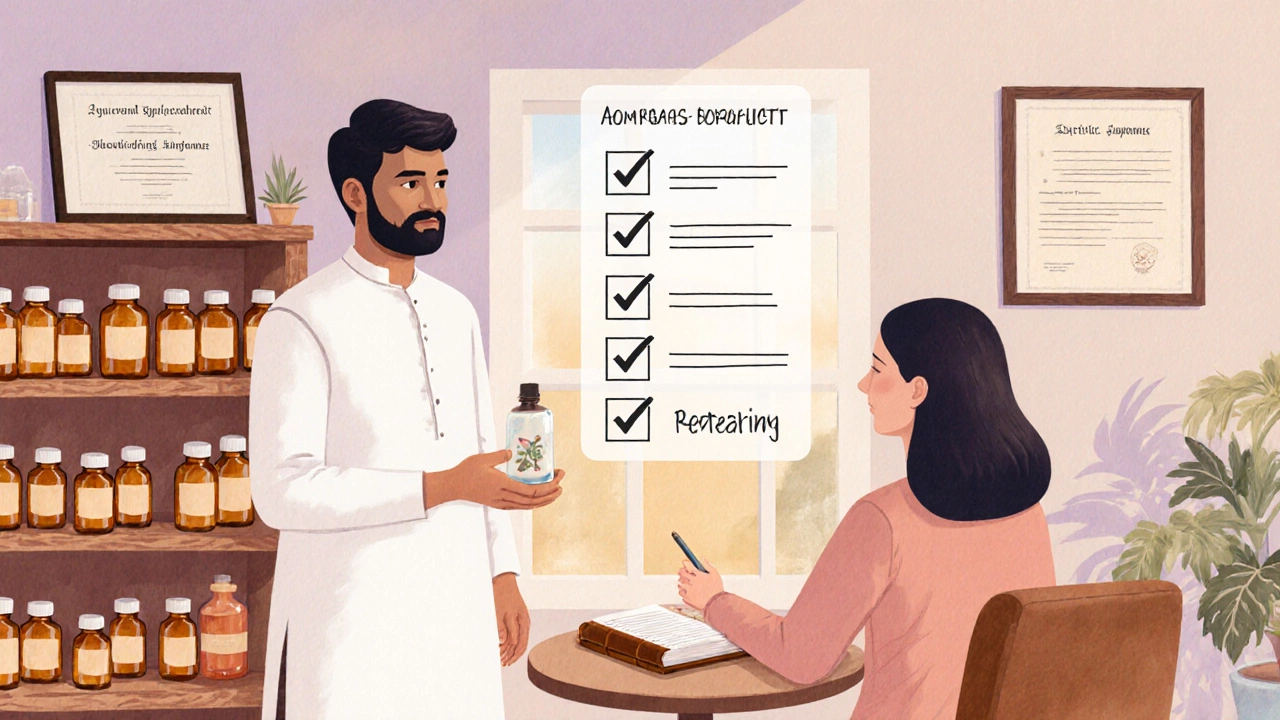Ayurveda Safety: What You Need to Know
 Oct, 12 2025
Oct, 12 2025
Ayurveda Safety Risk Checker
Risk Assessment
Enter your details to get personalized safety guidance based on UK Ayurvedic safety standards and clinical evidence.
Your Safety Assessment
Based on UK MHRA regulations and clinical evidence (12% of products exceed lead limits).
Critical Actions
People are curious about natural healing, but the big question is: Ayurveda safety. Is this ancient Indian system a harmless wellness trend, or does it carry hidden dangers? Below you’ll get the straight‑forward facts, practical tips, and red‑flags to watch for before you pop any herb or book a consultation.
Key Takeaways
- Ayurveda is a holistic system that combines diet, lifestyle, and herbal medicines.
- Most single‑herb preparations are low‑risk, but multi‑herb formulas can contain potent compounds.
- Regulation in the UK is limited; quality varies widely between manufacturers.
- Potential side effects range from mild stomach upset to serious liver or kidney injury, especially when combined with prescription drugs.
- Follow a safety checklist: verify practitioner credentials, check product certifications, start with low doses, and monitor your body’s response.
What Is Ayurveda?
Ayurveda is a traditional system of medicine that originated in India over 5,000 years ago. It aims to balance the three doshas-Vata, Pitta, and Kapha-through diet, daily routines, and plant‑based remedies. The word itself means “knowledge of life.” While it has deep cultural roots, modern use varies from gentle lifestyle advice to potent herbal prescriptions.
How Ayurveda Is Regulated in the UK
The UK’s Medicines and Healthcare products Regulatory Agency (MHRA) treats most Ayurvedic products as food supplements, not medicines. That means they don’t have to undergo the rigorous clinical trials required for prescription drugs. Manufacturers must label ingredients, but the agency can only act when a product is proven harmful. As a result, quality and safety can differ dramatically between brands.

Common Ayurvedic Herbs and Their Safety Profiles
Below is a quick look at five popular herbs. Each has a long history of use, yet the scientific data on safety is mixed.
| Herb | Traditional Use | Key Active Compounds | Common Side Effects | Precautions |
|---|---|---|---|---|
| Ashwagandha | Stress reduction, stamina | Withanolides | Digestive upset, drowsiness | Avoid in pregnancy, watch thyroid meds |
| Turmeric (Curcuma longa) | Anti‑inflammatory, joint health | Curcumin | Stomach irritation, gallstone risk | High doses may interfere with blood thinners |
| Triphala | Digestive tonic, detox | Amla, Haritaki, Bibhitaki extracts | Loose stools, electrolyte loss | Limit if you have IBS or ulcerative colitis |
| Neem | Blood purification, skin conditions | Azadirachtin | Liver enzyme elevation | Do not use long‑term without monitoring liver function |
| Guggul | Cholesterol management | Guggulsterones | Rash, thyroid stimulation | Risk of hyperthyroidism; avoid if on thyroid meds |
Potential Side Effects and Contraindications
Even “natural” doesn’t mean “risk‑free.” While most single‑herb supplements cause mild issues like nausea, some formulations contain heavy metals (lead, arsenic) or adulterants. A 2023 review of Ayurvedic medicines in the UK found that 12% of tested products exceeded the legal limit for lead.
Serious reactions can include:
- Liver toxicity (especially with high‑dose neem or guggul)
- Kidney damage from sustained use of certain mineral‑based rasayanas
- Allergic skin eruptions from essential oil concentrates
Pregnant or nursing women should be extra cautious. Herbs like ashwagandha and guggul are generally advised against because they can affect hormone levels.
Interactions With Prescription Drugs
Herbal actives can boost or block the same enzymes that process pharmaceuticals. For example, turmeric’s curcumin may inhibit cytochromeP4503A4, raising the blood concentration of statins or certain antidepressants. Ashwagandha can enhance the sedative effect of benzodiazepines. Always talk to your GP or pharmacist before adding an Ayurvedic supplement to a regimen that includes prescription meds.

Choosing a Reliable Practitioner and Product
Not every practitioner labeled as an “Ayurvedic doctor” has formal training. In the UK, the Ayurvedic practitioner register is voluntary. Look for practitioners who hold a BAMS (Bachelor of Ayurvedic Medicine and Surgery) or have completed recognized postgraduate courses from universities such as the University of Southampton’s Centre for Ayurvedic Medicine.
When buying products, follow this quick checklist:
- Check for a UKCA or CE mark indicating compliance with safety standards.
- Read the full ingredient list; avoid vague terms like “herbal blend” without specifics.
- Look for third‑party testing certificates (e.g., ISO17025 labs).
- Start with the lowest recommended dose and monitor how you feel for 2‑3 weeks.
- Keep a log of any symptoms, especially if you’re on other meds.
Practical Safety Checklist
- Verify credentials: practitioner’s qualifications, registration, and client reviews.
- Research the herb: understand its active compounds and known risks.
- Check for contaminants: look for lab reports on heavy metals and pesticide residues.
- Start low, go slow: only increase dose if you tolerate the initial amount well.
- Monitor interactions: use a medication‑herb interaction app or consult a pharmacist.
- Know when to stop: discontinue if you experience persistent nausea, rash, or abnormal blood tests.
Frequently Asked Questions
Can Ayurveda cure chronic diseases?
Ayurveda focuses on prevention and symptom management rather than outright cures. Some studies show modest benefits for conditions like osteoarthritis or anxiety, but it should complement-not replace-conventional treatment.
Are Ayurvedic supplements regulated like vitamins?
Yes. In the UK they fall under the food supplement category, meaning they do not require the same clinical evidence as medicines. This makes product quality and safety highly variable.
What should I do if I experience side effects?
Stop the product immediately, note the exact herb and dosage, and contact your healthcare provider. Blood tests for liver and kidney function can help pinpoint the cause.
Is it safe to use Ayurveda during pregnancy?
Most practitioners advise against strong tonics like ashwagandha, guggul, or any herb known to affect hormonal balance. Mild teas such as ginger or fennel are generally considered safe, but always get medical clearance first.
How can I verify the purity of an Ayurvedic product?
Look for independent laboratory certificates that test for heavy metals, pesticides, and microbial contamination. Reputable brands often place a QR code linking to the full report.
Bottom line: Ayurveda can be a helpful addition to a balanced lifestyle, but safety isn’t automatic. By checking credentials, scrutinizing product labels, watching for interactions, and listening to your body, you can enjoy the benefits while keeping risks in check.